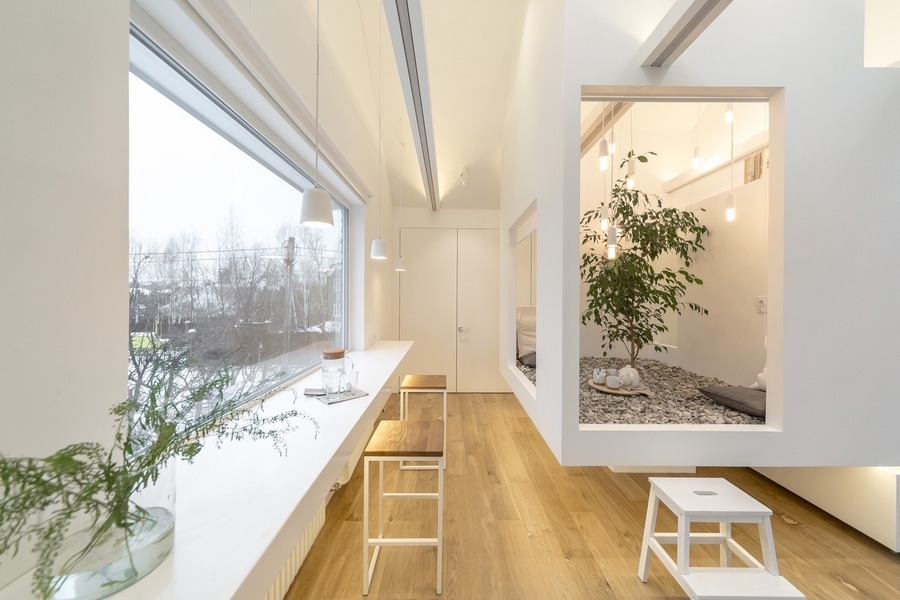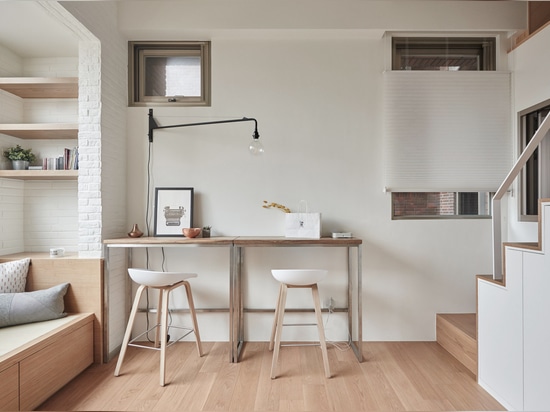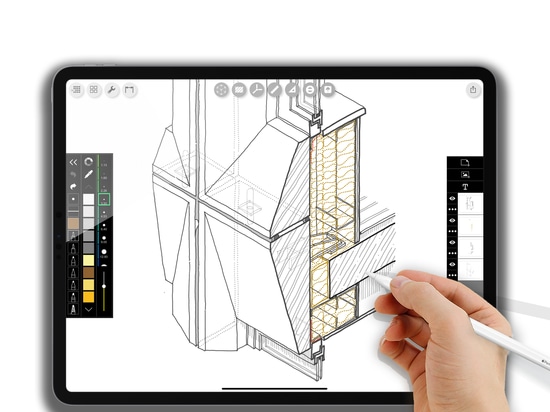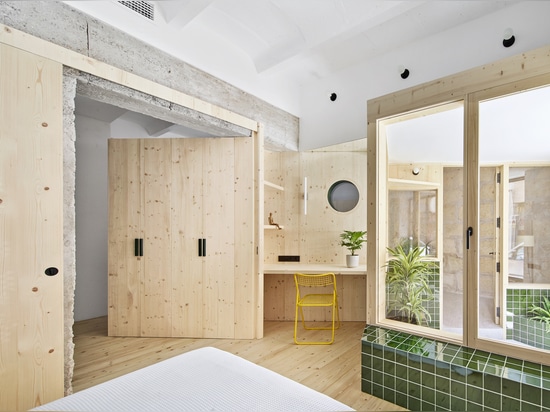
#RESIDENTIAL ARCHITECTURE PROJECTS
Tips for Architects Working At Home During COVID-19
The outbreak of COVID-19 has caused an estimated 900 million people around the world to remain at home.
Among them are architects and designers who have been asked to work remotely to prevent the virus from spreading through the workplace. For many architects, this is undoubtedly a new territory. However, for ArchDaily, it is not, and we can assure you that it is possible not only to work from home, but to use this time to greatly enhance your skills, knowledge, and development as an architect.
Over recent years, we have had a front-row seat as architects, manufacturers, innovators, and educators have developed new ways of digitally exchanging architectural designs, ideas, and experiences. Now, architects are settling into their new remote working environment, where digital technology will be essential to continue to collaborate among peers and clients. In response, we have created a broad list of tips and resources that can help you find your feet, restore your confidence, and activate your imagination.
While the COVID-19 pandemic has brought a wave of sadness, uncertainty, and disruption, we want to remind you that although we have little control of this situation, we all have full control of our response and our time. We encourage all architects and designers to do what we do best: face the future with optimism and creativity, and adapt to your present circumstance so that when the coronavirus pandemic passes, which it will, we will emerge ready to design a better future.
To Begin: Some General Advice
Follow official guidelines: In addition to the useful tips in this article, it is important to follow the advice of central organizations involved in the global response to COVID-19. Read the latest advice from the Centers for Disease Control and Prevention (CDC), the World Health Organization (WHO), and your local public health authorities.
Limit your news diet: It is important to keep up to date on the latest developments from reputable sources. However, constant monitoring of news and social media will not only disrupt your workflow but needlessly increase anxiety. During your working hours, our advice is to avoid them entirely.
Maintain a routine: Even when working from home, a daily routine is important for maintaining your productivity, mental health, and happiness. We will offer more detailed tips on this below.
Stay connected and be a calming influence: It is only natural for people to become worried or anxious during a time of such unrest. The central goal of this article is to highlight how your time away from the office can be a major positive opportunity, allowing you to adopt new skills, habits, and knowledge. When keeping in touch with friends and family, do so in the same spirit of positivity and kindness.
Maintaining Your Workflow: Software and Technology
Move your projects to the cloud: Today, many design systems offer cloud-based services, such as Autodesk BIM 360 and Graphisoft BIMcloud. An alternative solution for maintaining a shared network among BIM models is by mirroring your workplace computer’s screen with your home computer through apps such as Splashtop.
Move the creative process to the cloud: Today, many apps and programs are recreating the sketchbooks and sketch rolls that defined the design process of physical offices. Chief among them is Morpholio, whose Trace and Board apps allow designers to sketch, design, and present proposals for each other, and clients. As the COVID-19 crisis unfolds, Morpholio is offering a one-month free trial for both apps, which can be accessed here.
Move your files and folders to the cloud: Platforms such as Dropbox and Google Drive allow for free storing and sharing of information in a secure way, which integrates easily with your computer’s file explorer/finder window panels.
Stock up on apps: Last year, during our month-long study on Work, we compiled the best architecture apps available for iOS and Android. Check them out here.
Prepare documents together: Use Microsoft Office 365 or, like ArchDaily, Google G-Suite to allow numerous team members to edit text files, spreadsheets, and presentations at the same time.
Stay in close contact: At ArchDaily, we use Slack channels to share ideas and organize strategies. A basic free version of Slack is still a useful ‘all-in-one’ tool, allowing people to plug in their Google calendars, Trello boards, and even birthday lists. Ensure that your Slack interface is properly structured – too many channels will mean information is too disparate and will become lost. Our strategy is to organize channels by team location, and team purpose. Slack also allows team members to signal their ‘status,’ informing others if they are in a meeting, away, sick, or available.
Hold virtual meetings regularly: At ArchDaily, virtual meetings are conducted via Google Meet, which simply requires a Google account to use. For more extensive video conferences, we use Zoom to create a smooth interface between all members. Holding video meetings is essential for maintaining a sense of community among colleagues and avoiding misinterpretation, so use them to their maximum effect. At ArchDaily, video meetings take place every single day, sometimes with two people, and sometimes with 70.
Manage your projects and resources: At ArchDaily, we use Trello to map out the development of content and ideas, allowing each team member to understand what stage each project is at. In architectural practice, Deltek and Newforma offer a more in-depth, extensive means of structuring all project information and exchanges.
Keep your tool range to a minimum: Funnel communication and file sharing through as few avenues as possible. In a physical office, you would likely only exchange information through talking, emailing, or folder exchange. Likewise, in a virtual environment, aim to limit communication channels to one text-based platform (such as Slack), one video platform, and one file-sharing platform. This will minimize confusion and miscommunication, and enhance productivity.
Creating a Healthy Work/Life Balance
Take inspiration from idols: in organizing your daily routine, take a look at the engaging graphic by Info We Trust, which depicts how the world’s most brilliant people scheduled their days.
Establish a dedicated work area: Take the time to set up a dedicated home office. To enhance productivity, consider acquiring a large screen such as a TV, or if budget allows, two monitors, to allow for a smoother workflow. If it appears you will be working from home for more than a few weeks, also consider investing in a good keyboard and multi-function mouse. Be conscious also of ergonomics, finding a comfortable chair with back support. As part of this, prop up your screens to eye level using either a stand or books. Most importantly, ensure you set up your space in a well-ventilated area, which has access to natural light. Find some inspiration from our recent article on 35 home working spaces.
Re-evaluate your working hours: working from home means no long commutes and no strict one-hour lunch break. Examining your workflow, you may find it possible to accomplish your tasks in 5 hours rather than the traditional 8 hours mandated by office hours. Use this “new time” as an opportunity to learn new software, study a topic that will benefit your performance, or explore some of the other resources in this article.
Mitigate against distractions: Consider using the Pomodoro Technique by breaking your schedule into 25-minute intense work blocks, divided by 5-minute breaks. If you find yourself frequently distracted by phones and the internet, then place your phone in flight mode/sleep mode, and place it out of your eye line.
Find your zen: Let’s face it, we have all fantasized about being ‘that’ person who mediates every morning in preparation for the tough day ahead, or practices yoga in the evening to mark the end of a long day. When working from home, this point of transition between work and life is more important than ever. Check out EkhartYoga’s free yoga and meditation classes, designed to relieve stress and anxiety.
Keep active: Depending on your location, it may not be possible to leave your home for exercise. To address this, The New York Post recently published a list of at-home fitness apps to use during the COVID-19 outbreak. If possible, we also recommend switching off from work by leaving the house, going for a walk or run, and interacting with nature.
Switch off: Discipline is important when working from home. While it is vital to maintain productivity levels during your core work hours, it is equally important to detach from work when needed. We recommend this list by The New York Times on what to watch, read, and listen to when in need of a distraction. For some architectural intrigue, also check out our feature on this excellent abandoned architecture YouTube channel.
Opening Your Mind: Online Learning
Learn new software: With more command over your routine, now is the perfect time to integrate new software into your arsenal. Check out a previous article of ours that offers the best places to find software tutorials.
Virtually visit a museum: While many museums have closed to the public, their exhibits can still be explored virtually. Google Arts and Culture are offering virtual tours of dozens of international museums, while the Guggenheim and Smithsonian National Museum of Natural History are also offering virtual experiences. In Europe, the Rijksmuseum has also established a virtual experience.
Take an online course: Last year, we assembled a list of 12 online courses covering a range of subjects related to architecture. Check them out again here. There is also a range of online courses from top universities available to the public, such as the ever-popular Harvard course “The Architectural Imagination”.
Learn more about construction and materials: In addition to our coverage of online courses related to architecture, we created a specific list of excellent online courses that focus on materials and construction. If you've always wanted to understand more about construction processes, structures or materials, this list of online courses is for you.
Improve your drawing skills: During our month-long study on Representation, we produced an article detailing the best drawing tutorials on YouTube. Check it out here.
Listen to interviews from top architects: While the Louisiana Museum of Modern Art is closed, their impressive collection of architectural interviews is still very much operational, courtesy of the Louisiana Channel. Check out our highlights here. More standout interviews can be found on our list of the top architecture interviews of 2019.
Watch architectural TED Talks: Throughout the years, we have highlighted numerous TED Talks that are particularly relevant to architects – we even interviewed the founder of TED last year. Recently, we created a list of 20 such TED Talks that show how architecture can change the world.
Learn more about remote working: Linkedin Learning has produced an excellent course on working remotely, offering tips on adjusting to your new environment, and an overview of virtual communication tools.
How the Architectural Community Has Responded
GBBN: "The technological side of the transition was surprisingly easy. So many of the Beijing office’s functions are integrated into WeChat—a platform that allows for spontaneous meetings between project teams, messaging, screen sharing, file transfers, and phone calls—that communications between project teams were only minimally disrupted. Meetings with clients began being held on Zoom, which had not been widely adopted previously. When people did have to stop by the office, GBBN minimized risk of exposure by creating a schedule to ensure that only one person was there at a time."
MAD Architects: "We have around 100 people in our Beijing office. With so many projects going on, and staff in different time zone, it was extremely challenging. First of all, we made sure each of us has the Internet and computers at the place we’re staying. Then we access the office files via remote desktop software. Our daily internal and external meetings are replaced by zoom e-meetings. It worked. Just face-to-face communications were not there anymore, which is extremely important for architecture firms. Besides working, our colleagues miss the time we’re with each other. The bonds are still strong. We had our “back-to-work cloud happy hour” in mid-February. 70 of us showed up on zoom, caught up with each other, and paid tribute to the medical teams in the then hard-hit area. We had this video of the “cloud happy hour” and got spotted by the Wall Street Journal. We value these two months but look forward to meeting with each other again very soon."
Henning Larsen: "Set up a comfortable workplace, preferably away from the fridge, tv, or other distractions. For me, it works better to keep the morning routine as if I was going to the office. So that means: get dressed comfortably, but not in sweats. Have an early, healthy breakfast, and start work at a normal hour. As far as teamwork goes, communicate clearly and as often as necessary. And do your best to keep up your team spirit! Update each other on who is doing what, and update everyone when you have completed a task. There will be a lot more emails than usual. If you are having issues with your network and have trouble sharing your screen while in a call, send quick screenshots to everyone to keep the flow more efficient. And remember. Stay calm, get up, walk around, and don’t panic."
Mizzi Studio: "Despite the fact that these are hard times, my biggest tip would be to try make the most of this unique period. Architects arriving home on time? How crazy is that!.. Now I manage to give my children bathtime every night and as a result have never been closer to my family. Stay safe!"
SOM: "Stay as educated as you can and be proactive. Be flexible, communicate often, and listen to your people. There is so much unknown about Covid-19, but it is the job of a leader to plan for a range of scenarios and make sure all preparations have been made, and lead with a spirit of optimism. To that end, we’ve taken a very deliberate approach to communication as we work remotely, knowing that this is an uncertain and anxious time for a lot of people. We’re checking in with our teams regularly, taking feedback and making adjustments, and sharing updates from every city and every office, with everyone in the firm. In challenging times, our focus is on maintaining trust and keeping lines of communication open with our teams, collaborators, and clients. Perhaps most important, though, is that we don’t forget to take time to laugh and have fun – we all need a bit more joy right now."
Foster + Partners: "We have been trialing home-working for some time – our Asia offices have all done it successfully, they are now open again in Hong Kong, Shenzhen, Shanghai, and Beijing. Over 90% of our teams in London are currently working efficiently and collaboratively from home."
Gensler: "External mobility is a good thing as well. That mobility, choice, and virtual collaboration are invaluable in today’s health crisis. As we have seen, organizations are able to announce a work from home strategy and implement it immediately. This is because of the three-decade transformation of work, which created the technologies, management styles, and work styles that have enabled a virtually connected organization. We are a “work from anywhere” culture, and this new paradigm will help companies and workers stay productive in the office and at home in the face of this health crisis."
S3DA Design: "Remote work would not be a priority if it was not for the coronavirus. But besides being a safety measure, remote work has many benefits too. Since there is no inspection, it can cut the costs of onsite visits. It can also be a huge time saver, as there will be no need for traveling. Simultaneously, this leads to less carbon emission. While remote work has been forced upon us, we should also appreciate its benefits."




